By Eric Vandenbroeck
Mawlamyine, known as Moulmein
by the British, was the first capital of British Burma until 1852 after they
took control of the area following the First Anglo-Burmese War. Today, it’s the
third largest city in the country after Yangon and Mandalay and known for its
good food. Even more so than Rangoon, Moulmein still captures the essence of
the nineteenth-century plural society – just as it also retains a rich
collection of colonial-era buildings. It is also known for its association with
British writers Rudyard Kipling and George Orwell.
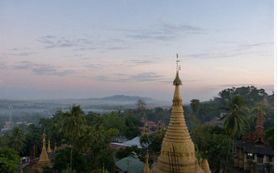
Born Eric Blair, Orwell’s maternal grandmother lived here, and he moved
to Moulmein in April of 1926 and stayed for less than a year before being
transferred to Katha in Upper Burma. Orwell kept to himself during much of his
time in Burma, but his affinity for the people and the culture is clear as he
learned Burmese and was said to be fluent before he left. He also acquired some
native tattoos consisting of little, blue circles on his knuckles which, as
stated previously, many Burmese in rural areas believed were helpful in
protecting against bullets and snake bites. Unfortunately, they weren’t all
that helpful in preventing disease. Orwell's diagnosis of tuberculosis in
December 1947 signaled the downward spiral of his health. His Burmese
experiences played heavily in his early works such as the novel Burmese Days
and the essays “A Hanging” and “Shooting an Elephant.”
Mawlamyine also made a deep impression on writer Rudyard Kipling
twenty-seven years earlier when he passed through in 1899. What he saw inspired
him to try and translate that vision to the rest of the world in his poem
Mandalay. He wrote in more detail in letters to friends. In one, he describes
his first impression of the town:
Moulmein is situated up the mouth of a river which ought to flow through
South America, and all manner of dissolute native craft appear to make the
place their home… Visitors are rare in Moulmein – so rare that few but
cargo-boats think it worth their while to come off from the shore. Strictly in
confidence I will tell you that Moulmein is not a city of this earth at all.
Sindbad the Sailor visited it, if you recollect, on that memorable voyage when
he discovered the burial-ground of the elephants. Kipling described it as, “a sleepy town,
just one house thick, scattered along a lovely stream and inhabited by slow,
solemn elephants, building stockades for their own diversion. There was a
strong scent of freshly sawn teak in the air.”
Today, Mawlamyine is still situated on that river, still visited by
native boats, and to my eye, the river still moves with a slow, muddy current
that would look perfectly at home in South America.
Mawlamyine
native river boats
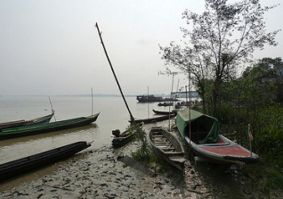
However, I didn’t see any elephants or smell freshly-cut teak. It is a
city alive with trucks and motorcycles, humming with activity and eagerly
awaiting the economic changes that have been promised.
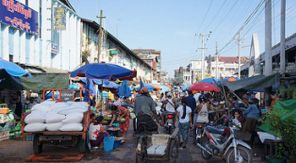
The place is a beehive of ceaseless activity, typically of most Asian
markets.
Mawlamyine seems to have less grit and more charm than my last stop at Hpa-An. However, this area has seen its fair share of
conflict and trouble during the decades the Burmese military has kept the
people under its thumb.
Although lacking the international press coverage of the government’s
conflicts with the Karen and the Kachin tribes, the Mon insurgency was a
concern here just a few short years ago. Several organizations representing the
Mon people have been formed from 1952 to 1996, and some of them have waged war
against the government attacking police stations and carrying out bombings over
the years. Burmese government troops captured the Mon National Liberation Army
(MNLA) headquarters in Thailand in 1990, but fighting continued in outlying
areas. Government and New Mon State Party (NMSP) representatives began
negotiations in Mawlamyine in December of 1993 and signed a ceasefire agreement
in June of 1995. At least 12,000 refugees fled to Thailand during the ongoing conflict.
The last bombings took place in Mawlamyine in May of 2009, and a peace
agreement was signed here in February of 2012.
Unlike the Karen, the Mon did not play a significant role in assisting
British officers operating behind enemy lines in Burma during the war.
During the war, the Japanese, who had assisted the formation of the
Burma Independence Army (BIA), granted a national independence with Ba Maw in
charge of the Burmese cabinet. It was to be a dictatorship along fashionable
fascist lines. The slogan of the new army under Aung San at the time was
"One Blood, One Voice, One Command" (ta-pyi,ta-than,
ta-meint), still today the de facto slogan of the
Burmese military. Ba Maw ‘s regime outlawed the teaching of all minority
languages.
After 1962-63, General Ne Win regime's suppression of non-Burman
cultural and political identities, epitomized by the banning of minority
languages from state schools, drove a new wave of disaffected ethnic minority
citizens into rebellion.
Shortly after seizing power in 1962, Ne Win denied the need for a
separate Mon culture and ethnicity. According to Ne Win, "the Mon
tradition had been fully incorporated into Burmese national culture, and thus
required no distinct expression.” (Emmanuel Guillon The Mons: A Civilization of
Southeast Asia, 1999, p.213).
In August 1991, the then-SLORC chairman, General Saw Maung, made a
similar speech, in which he denied the need for a separate Mon identity. (An
extract from this speech is quoted in Mikael Gravers, Nationalism as Political
Paranoia in Burma: An Essay on the Historical Practice of Power, 1996, p.240.)
Since the 1970s, many thousands of displaced Mon villagers have voted
with their feet, seeking refuge in the insurgent-controlled “liberated zones”
(and later, refugee camps) along the Thailand-Burma border.
Approximately 6,000 Mon refugees living in the camps on Thailand-Burma
border were forcibly repatriated to Halockhani camp
in Burma in 1996, despite the appeals from the Mon National Relief Committee
and the Mon Refugee Committee. Next the Myanmar Army
attacked Halockhani a
few months later, forcing a large number of refugees back to Thailand.
Consisting of all ethnic groups that are in collision with the Myanmar
Government currently there are roughly 150,000 Burmese refugees in nine
official camps on the Thai-Burma border, and more than two million Burmese
migrants residing primarily in urban areas of Thailand. Refugee camps are hardly
natural places to live.
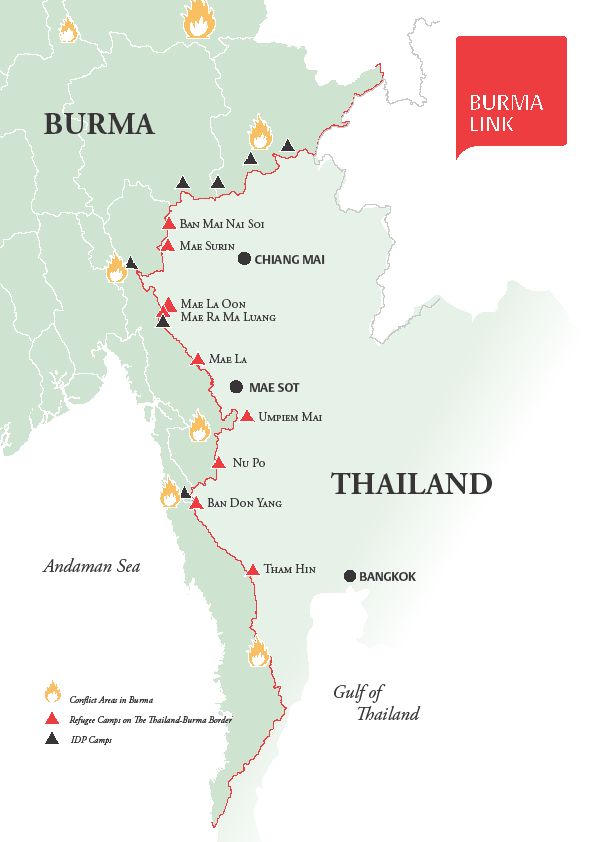
Forced migrants also have largely been excluded from peace process
negotiations, or broader political discussions.
Tomorrow we will travel by bus towards the Thai Border and enter via Mae
Sot in the evening.
We will also pass near the area where, led by two children, a Karen
splinter group called “God's Army” emerged in the aftermath of the 1997
operation Spirit King offensive when the Burmese army (about 100,000 men) moved
in to swamp the route of a multi-million pound gas pipeline and clear thousands
of people before them. A hundred thousand Karen fled to refugee camps across
the Thai border.
The bizarre story of the two boys began sometime in 1997 when Burmese
troops came to their village as part of a military sweep through Karen
territory related to securing the route of an oil pipeline. When the Burmese
army attacked, the twin nine-year-olds rallied defenders of their village by
shouting “God's Army!” and leading them to victory over the Burmese soldiers.
Soon there were stories that the boys possessed magical powers, including the
invulnerability to bullets and landmines.
Later, Luther Thoo recalled that the boys did
what was necessary.
“We had to defend ourselves because we didn't like anyone to hurt us. We
love our motherland, so we chose to fight. We got seven rifles from the KNU and
there were seven of us. We used them to fight against the Burmese army. We
prayed before we fought, and then we won.”
To put this “defend ourselves” in a possible perspective; taken some
years later when the same type of attacks were still going on, underneath two
satellite photos, showing the disappearance of villages and a buildup of army
camps. Left, the same village on May 5, 2004, on the right, Feb. 23, 2007, with
all structures removed.
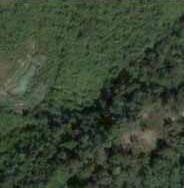
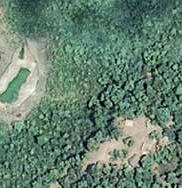
The American Association for the Advancement of Science (AAAS) sayd high resolution satellite photos show evidence of
destroyed villages, forced relocations and a growing military presence in 25
sites across Karen state and surrounding areas. Project director Lars Bromley
said the non-profit group looked at photos taken before and after reported
attacks on ethnic minorities. He said 18 villages had almost entirely
disappeared. Others had appeared near a military camp in what researchers
concluded was a forced relocation.
The AAAS Geospatial Technologies and Human Rights Project conducted
analyses of satellite imagery in 2007 and 2009 to corroborate reports of
attacks on villages in Karen State, Shan State, and Thailand that were carried
out by the ruling military junta. Within the areas of imagery analyzed in 2007,
the bulk of the sites (18) were removed villages or villages with removed
structures, with other sites including military camps (4), possible forcibly
relocated villages (2), and one refugee camp on the Thai border. A follow-up
analysis conducted in 2009 found further evidence of destruction at 25 of the
49 locations examined.
The stronghold for the God’s Army was a jungle camp in Ka Mar Pa Law,
Myanmar, an isolated area on “God’s Mountain” reached by an 11-hour trek from
the nearest town in Thailand. The village was made up some ramshackle huts.
There was no electricity or running water.
God’s Army members were subject to strict rules of behavior including
abstinence from sex, alcohol, milk, eggs and pork. Church services were held at
least once a day.
Johnny, left,
and Luther Htoo, age 12
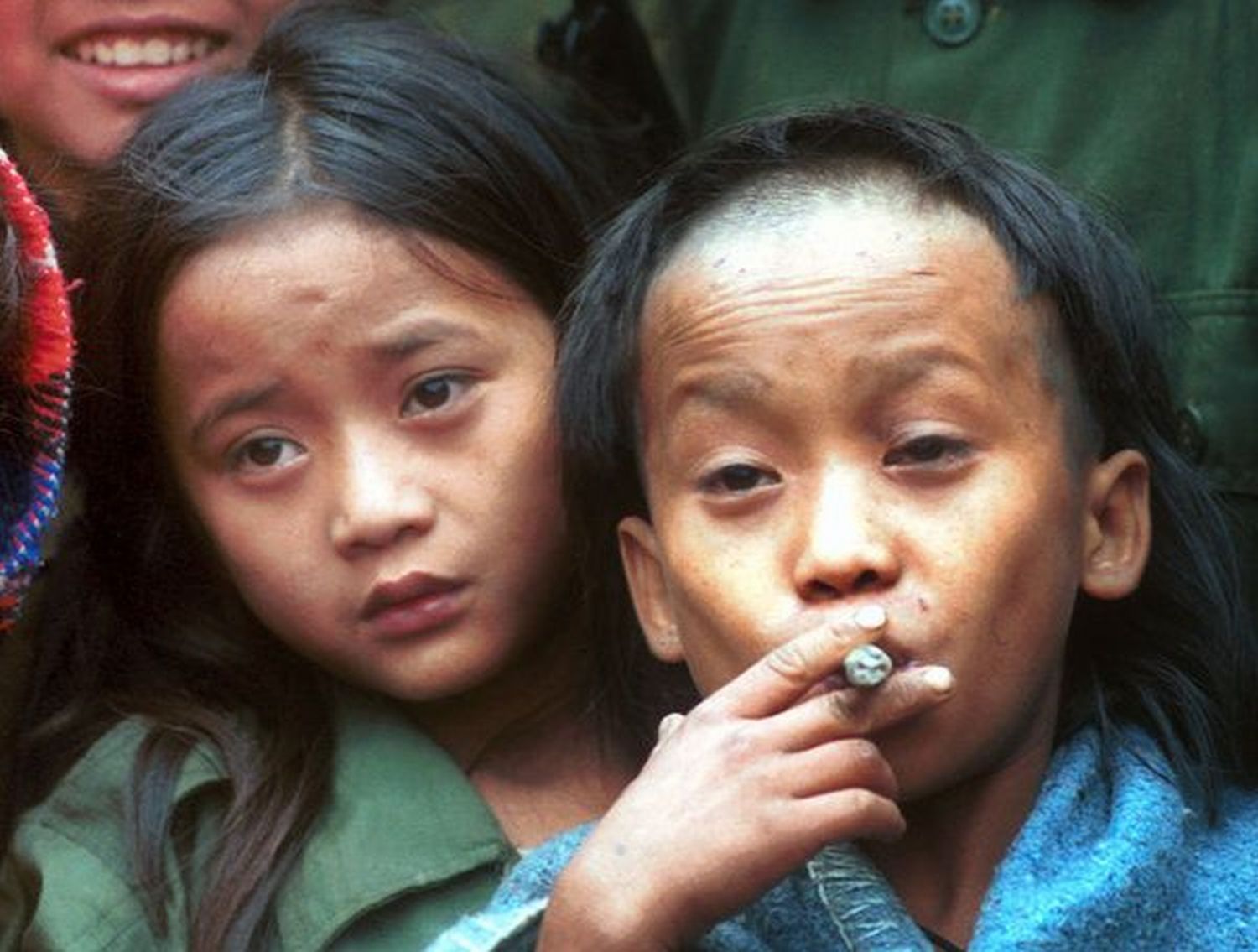
October 1999, the group numbered about 150 armed men. That month God’s
Army first came to people’s attention when they took in a group that called
themselves the Vigorous Burmese Student Warriors, who had stormed the Burmese
Embassy on Bangkok and took 26 people hostage. Since the thwarted 1990
elections in Burma, former student radicals had fled the country into
neighboring Thailand. In August 1999, the VBSW formed as a branch organization
opposed to the strategy of peaceful protest of the All Burma Students
Democratic Front. On October 1, 1999, a group of five members raided the
Burmese consulate in Bangkok and took 89 people hostage. The group demanded
that negotiations be opened between the National League for Democracy and the
Burmese government, and that a Parliament be convened based on the results of
the 1990 election. However, they soon relaxed their demands and began to let
the hostages go, and the Thai government eventually allowed the VBSW members to
flee by helicopter to the border with Burma.
The action provoked the Burma Army into concentrating its fire on the Ka
Mar Pa Law base. Now things started to go sour for the boys. Angered by the
embassy siege (and hoping to dislodge “God's Army' in order to exploit local
hardwood stands), in early January 2000 the Burmese Ninth Division together with Thai armed forces started to shell the Karen
rebel village, killing a number of fighters and civilian followers.
Shambles turned to disaster when ten desperados from Kamarplaw
crossed into Thailand towards Ratchaburi Hospital. By Luther's account, student
warriors and some members of God's Army went to the hospital to ask for
medicine and doctors to help people wounded by the shelling. It is not exactly
clear what happened at that point but they ended up occupying the Ratchaburi
Hospital. They demanded an end to Thai military shelling of their camp and
medical treatment for their colleagues and villagers.
At dawn, six truckloads of elite Thai commandos stormed the hospital,
ending the 22-hour standoff there, killing all 10 of the insurgents, who were
aged from teenagers to men in their thirties. Their bodies were displayed
proudly by Thai authorities, who said they had been killed after a one-hour
fire fight. Miraculously, none of the hostages were killed or hurt.
Afterwards, several of the hostages described the insurgents as “armed
men with soft hearts.” They said the hostage-takers had given up and were
killed by the Thai security forces after they surrendered. One hospital worker
told the Bangkok Post, the insurgents “were shot in the head
after they had been told to undress and kneel down.” Photographs of the dead
men showed them with their hands tied and gunshot wounds in the back of their
heads. This hardly fit the description of men killed in a gun battle. There
also weren’t many bullets in the building.
As recent as July, up until a
few weeks ago, there
was still fighting by Democratic Karen Buddhist Army - Brigade 5.
Democratic Karen Buddhist Army - Brigade 5, is an armed insurgent group
in Myanmar. The group is led by Bo Nat Khann Mway,
also known as Saw Lah Pwe, and split from the
original Democratic Karen Buddhist Army in 2010. The group is loosely
affiliated with the Karen National Union and the Karen National Liberation Army
(KNLA) which sees itself as representing all Karen people of Burma.
Mawlamyine itself is a
peaceful place today.
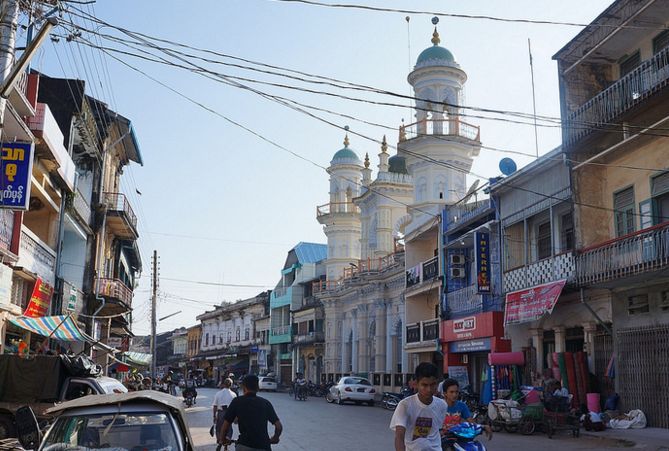
Moulmein is still laid out just as the colonial-era plural society
demanded. Around the main market, along the banks of the river where the
jetties protruded, remain the principal immigrant trading communities. These
are predominantly Chinese, plus the many peoples who came from South Asia,
still numbering some eighty thousand, I am told. They mainly occupy the north
end of Lower Main Road, close to the market. Here are the mosques, including
the biggest, the Kaladan, built in grey-green brick and dating from 1846. A few
buildings further south towards the market is the smaller Moghul Shia mosque.
For the non-Muslim South Asian community, there are about fifty temples,
and these all advertise themselves as catering to the faithful from the various
individual regions where immigrants originated.
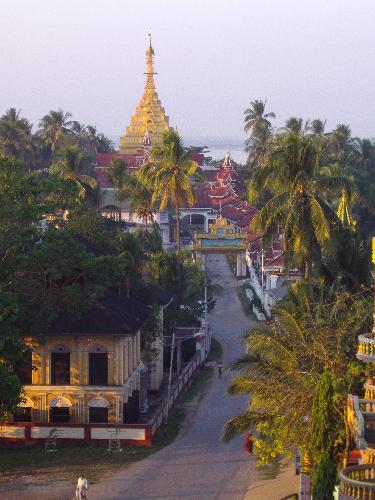
Finally, today, the United Nationalities Alliance (UNA), composed of
eight ethnic political parties had a meeting in Yangon. I've been told by a
participant over the phone that that it seems they agree that a government’s
peace convention, scheduled to start on 12 January, will fail as it is unlikely
to lead to a genuine democratic federal union for the country. The United
Nationalities Alliance won
the largest number of seats in Kachin State.
Postscript 31 December 2015
Coming near the end of this particular investigation in conclusion I
like to return to my earlier question.
What can we learn from
Myanmar?
Myanmar is unique and not easily comparable to other states. Its
historical experiences preclude simplistic transference of its lessons abroad.
It presents an array of issues that, considered in comparative focus, may help
us understand not only Burma/Myanmar but other states that face a set of
similar (albeit not identical) dilemmas. Indeed, it has much to teach us about
intractable social and political problems throughout the world. Such inquiries
may also contribute to our theoretical understanding of a number of those
conundrums that bedevil other states. Internal conditions in Myanmar as well as
foreign responses to them may provide lessons about the efficacy of such
approaches in and to other countries.
Myanmar features many of the problems that face multicultural States and
raises a basic question: how might societies with many disparate ethnic and
linguistic groups achieve national integration without destroying local
cultures – creating nations and not just states. Should there be a uniform
state school curriculum in the national language, or can other local languages
be taught (see Switzerland for example), and if so at what levels?
Civil-military relations are also an issue in many developing states, and in
Myanmar the Burmese military has retained effective power since 1962.-certainly
one of the longest such reigns in the modern era. Political and social
pluralism is important in many societies, and Myanmar may offer lessons on the
effect of the presence or absence of various components of civil society on its
people and the political process. We could draw from Myanmar’s sad experience
with economic development how better to encourage equitable and sustained
growth that spreads across a diverse population. The military's opening to
foreign investment and the expansion of the local private sector have not met
economic expectations, and one might ask how rent-seeking and corruption
affected the attempt to reform a rigid socialist system.
We should question how international and indigenous political legitimacy
symbols and attitudes may differ and may be perceived, and what effect these
views have on hot' internal and external state actors. What does it take in
Myanmar for a government to be considered legitimate by its various peoples and
the international community?
We need to know what kinds of foreign policies toward Myanmar have
proven to be effective or ineffective. International organizations can learn
valuable human rights lessons from the Burmese situation that will help the
international community-individual states, international institutions such as
the United Nations or ASEAN, and international nongovernmental
organizations-improve conditions there. The Myanmar case may help us understand
whether the international community can effectively promote democracy, pluralism,
and better governance elsewhere, and if so, over what period and to what
extent.
Will there be peace between the government and the many ethnic groups?
Will they be able to maintain their culture in the midst of a tsunami of new
development and influence? The difference between real democracy and a thin
veneer of freedom (just enough to keep the tourists coming) could rest on how
much the ordinary people of Myanmar are prepared to risk, but it could also
rest partly on how readily citizens of other nations step up and demand that
their governments monitor events and hold the government of Myanmar
accountable.
For updates click homepage
here